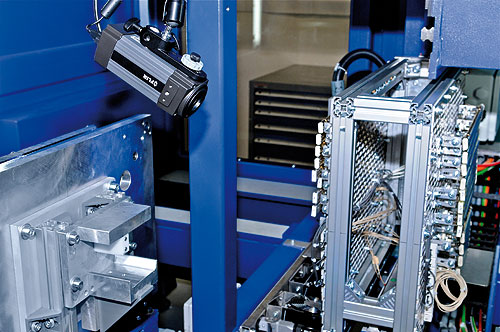Advantages of Infrared Welding in Thermoplastics Manufacturing
by Dave Clothier
FRIMO, Inc.
Infrared Welding
Depending on the product and application, the IR welding process is beneficial in that it allows for the following:
- No particles, e.g. for air- or oil-ducting components (more and more regulated by OEM norms and rules)
- The increased use of reinforced high-performance plastics, e.g. glass fiber
- Use of reinforced plastics for structural components and lightweight construction
- Higher yield strength in security-relevant areas
- Design freedom, with a view to complex 3D geometries
- Improved productivity, economic viability and energy efficiency
- Non-contact method
- Higher strengths
- Particle-free process
- 100-percent gas-tightness
For several years, the process of infrared (IR) welding has been gaining importance in the thermoplastics industry as a competitive alternative to classic joining techniques used in high-quality thermoplastic manufacturing processes, such as vibration and hot plate welding.
Method and benefits
IR welding is a non-contact joining method that, depending on the product and application, offers many advantages in the way of overall investment, process handling and quality results compared to traditional processes. It is equally well-suited for manufacturing both small and large components. Typical applications include automotive instrument panels, door trims and center consoles that have complex welding contours.
With the IR welding process, energy from the IR process is absorbed by the material and transformed into heat, resulting in the melting of the surface layer and allowing for plastic components to be joined by pressing them together. The heat is transferred without contact, and the heat input is fast, specific and energy-efficient.
Being contact-free, IR welding satisfies the ever-increasing demand for particle-free operation, especially when manufacturing components such as air and oil ducts, fluid containers, tank systems and filters or filter housings, as many original equipment manufacturers of such components are imposing progressively strict standards and regulations.
The IR welding process also allows for impressive design flexibility – even for complex 3D geometries – and is exceptionally well-suited for welding high-performance reinforced plastics, including glass fiber-reinforced plastics and polyamides, which are becoming increasingly commonplace in structural components such as those used in lightweight vehicle applications. In addition, the process offers extremely high degrees of strength and 100-percent gas tightness, which is of particular interest in the production of safety-related components.
Equipment and tooling
Along with the growing popularity of IR welding, there is an increased interest in high-speed process tools and equipment. The demand for IR welding machines that allow for high movement speed is on the rise, as high speeds are critical in terms of changeover times and are needed for energy-efficient and strong welding of high-performance plastics.
For this reason, certain leading-edge IR welding systems come equipped with linear motors, which are characterized by a high degree of accuracy, low maintenance and low-noise operation. These motors guarantee high precision through the retrieval of actual values from the route, allowing any slips of the drive train, e.g. the gear rack, to be completely eliminated.
In combination with this, IR emitters in the system only are switched on during the brief heating time cycle, allowing for lower consumption of resources and energy. This results in optimized parameter and control options that allow manufacturers to set the optimum movement and temperature values for the thermoplastic to be welded. This provides maximum strength of the welded joint, with a high degree of repeat accuracy.
Further, monitoring the temperatures that occur on the surface of joining partners when it comes to thermoplastic manufacturing is of high importance for quality assurance. Certain IR welding machines available today use thermal imaging for this task. Very small, light cameras, which are integrated into the machines, are used to guarantee complete process monitoring and documentation at all times. Data is transmitted to super ordinate systems so that it also can effectively be used for remote maintenance.
The control technology of such a system also can be perfected so that compensation of part tolerances within the IR welding process is possible. This is particularly advantageous in the case of welding gas- and liquid-ducting systems.

